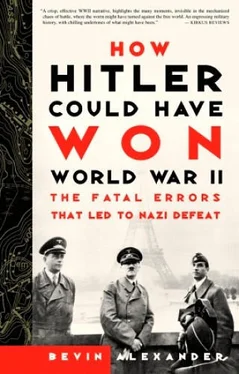Hitler had to gain a quick victory or be forced into a war of attrition that he could not win. Hitler refused to see this, and it was the cause of his destruction.
For immediate use in the attack, Hitler assembled 107 infantry divisions, 19 panzer divisions, 18 motorized divisions, and one cavalry division, a total of three million men, with supporting troops. This represented the bulk of the total German strength of 205 divisions. The Barbarossa forces included 3,350 tanks, 7,200 artillery pieces, and 2,770 aircraft.
The great weakness of the panzer divisions was the condition of the roads. In the vast Soviet Union there were only 40,000 miles of paved highways. Most routes were dirt and turned into muddy morasses in wet weather. In a panzer division fewer than 300 vehicles were fully tracked, while nearly 3,000 were wheeled and largely restricted to roads. In the west this had been little problem, because of the abundance of all-weather roads. In Russia their relative absence meant that panzer mobility would end with the first mud.
The Red Army was not prepared for the German onslaught, in part because of the condition of its forces, in part because too many troops were positioned right against the frontier, but also in part because Joseph Stalin had guessed wrong where the main German onslaught would come and put a preponderance of his forces south of the Pripet marshes.
The Russians assembled 171 divisions in five army groups or “fronts” along the frontier. Behind the five forward fronts, separate groups of five field armies were being formed as a second strategic echelon. This Reserve Front was assembling on the line of the Dnieper and Dvina rivers, some 180 miles east and 100 miles northeast of the frontier. Before hostilities these forming reserves were virtually invisible to German intelligence.
Soviet authorities had ample warning of the attack, but Stalin hoped the Soviet Union could escape Hitler’s wrath, at least for a time, and ignored plain evidence.
On March 20, 1941, Sumner Welles, United States undersecretary of state, informed the Soviet ambassador of the attack, picked up by the American commercial attaché in Berlin. Winston Churchill alerted Stalin in a personal note delivered on April 19, 1941, based on Ultra intelligence intercepts (which he didn’t reveal to Stalin). American Ambassador Laurence Steinhardt informed Molotov of reports to U.S. legations pin-pointing the attack almost to the day. High-altitude Luftwaffe reconnaissance aircraft made more than 300 overflights of Soviet territory in the weeks leading up to D-Day, June 22, 1941. On June 16, the German embassy evacuated all but essential personnel. There were many more warnings.
Up to the last day, the Soviet Union continued to supply Germany with raw materials, including 4,000 tons of rubber, plus manganese and other minerals shipped from the Far East over the Trans-Siberian Railway.
But Stalin had actually been preparing for war. On May 6, he took over personally as chairman of the Council of People’s Commissars, or prime minister, replacing Molotov, who remained foreign minister. It was the first time Stalin had taken a government office.
In April Stalin implemented readiness measures, including partial mobilization. He transferred forces from Siberia to the west, sent twenty-eight rifle divisions and four armies to the border, and began assembling a fifth army near Moscow. In late May he called up 800,000 reservists.
Nevertheless, the Soviet Union was not ready. Its forces were poorly arrayed, trained, and equipped. Soviet political leadership had been paralyzed by its fixation on maintaining peace. Hope clouded reality.
For example, when Mikhail P. Kirponos, commander of the Kiev military district, deployed some troops to the frontier in early June, the Kremlin countermanded the order, and told Kirponos flatly: “There will be no war.”
The purges had left a severe shortage of trained commanders and staff officers, unlike the German army with its long emphasis on officer quality, its experience in war so far, and its supreme confidence. Red Army officers had learned to keep a low profile. Any independent judgment might lead to a firing squad or a trip to a Siberian gulag.
Few troops were concentrated where most needed. Aside from more troops being stationed below the Pripet Marshes, they were spread evenly across the front, and not many were held back for counterattack. These dispositions played directly into German tactics of punching a few holes with overwhelming force, then sending powerful motorized forces rushing through the gaps into the rear.
The Soviets had about 110 infantry (or “rifle”) divisions along the western frontier. In theory they were about the same size (15,000 men) as German divisions, but in June 1941 they averaged only about 8,000 men.
The greatest fault of the Red Army was its organization of armored and motorized forces. It possessed fifty tank divisions and twenty-five mechanized (motorized) divisions, far more than the Germans, but Stalin had not accepted the German doctrine of concentration of armor. The largest armored formation was a mechanized corps of one motorized and two tank divisions. These corps were widely dispersed across the front, not massed as were German panzer formations. Furthermore, each corps’s divisions were often a hundred kilometers apart. Some corps had the job of supporting local counterattacks. Others were held in reserve to take part in counterthrusts under front (army group) control. Soviet armor, spread out in small packets, thereby repeated the error that the British and French had made in the 1940 campaign.
9 FALLING BETWEEN TWO STOOLS

AS HITLER LEFT BERLIN BY TRAIN FOR HIS NEW HEADQUARTERS WOLFSSCHANZE (wolf’s lair or entrenchment) near Rastenburg in East Prussia, Luftwaffe aircraft rose from airstrips at 3 A.M. Sunday, June 22, 1941, and bombed and strafed Soviet airfields, catching hundreds of planes on the ground and attacking any that rose into the air. Before the day was up, the Luftwaffe had destroyed 1,200 Red aircraft. Within days the Germans had driven most Soviet planes from the sky and achieved air supremacy.
German panzers massed at key crossing points broke across the frontier and drove deep into the interior. Everywhere they achieved almost total surprise and were successful, except in the south. Here the German infantry struck strong defenses west of Lvov (Lemberg) and on the Styr River.
Stalin’s belief that Hitler would make his main effort into Ukraine had resulted in the Southwestern Front being especially strong in armor—six mechanized corps, with a larger proportion of new T-34s than elsewhere. The T-34 was a great shock to the Germans. It had good armor, good speed, a high-velocity 76-millimeter gun, and was superior to any German tank. Mikhail Kirponos, Southwest commander, mounted armor attacks on both flanks of the panzer thrusts of Kleist’s Panzer Group 1. The 5th Army operating out of the Pripet swamps had a firm base for the assault. The 6th Army on the open steppe to the south did not. The fight was tough, but the two arms of the Russian pincers never met, and Kleist drove on to seize Lvov on June 30. From there the panzers swept past Rovno and Ostrog through the “Zhitomir corridor” toward Kiev.
In the extreme south, the 11th Army of Romanians and Germans attacked across the Pruth River into Bessarabia, winning it in a week, then moving on, with all-Romanian formations, to besiege Odessa along the Black Sea.
Army Group North pushed out of East Prussia, led by Panzer Group 4 (Hoepner), and pressed through the Baltic states toward Leningrad.
Читать дальше



![Джонатан Димблби - Barbarossa - How Hitler Lost the War [calibre]](/books/385421/dzhonatan-dimblbi-barbarossa-how-hitler-lost-the-w-thumb.webp)









